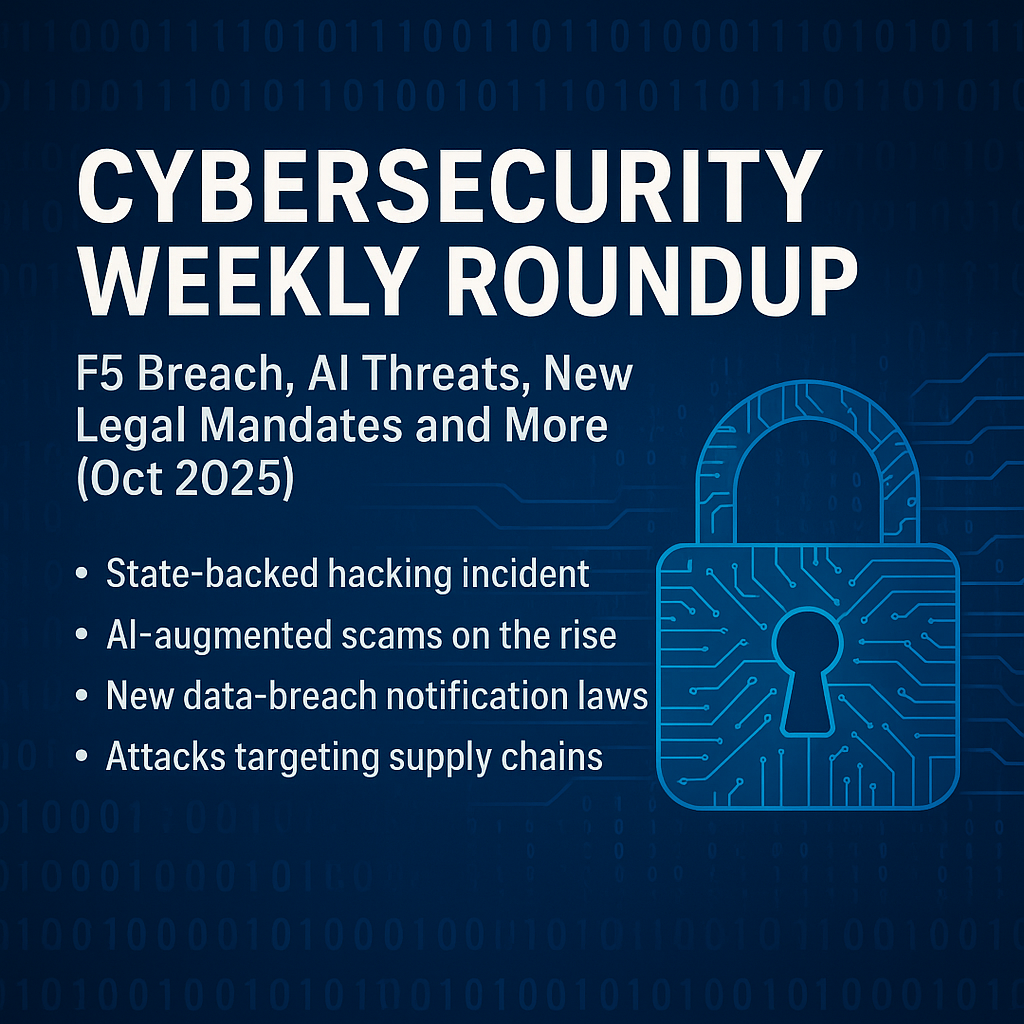Cybersecurity is a fast‑moving field, and every week brings new breaches, exploits and abuse of emerging technologies. We at 010 group, a Canadian IT‑services firm, want decision‑makers to stay ahead of these threats. This roundup summarises the most important recent developments and how to respond.
F5 Breach and Directive ED 26‑01
On 16 October 2025 Reuters reported that state‑backed hackers from China infiltrated F5’s network by exploiting vulnerabilities in its BIG‑IP and F5OS devices. Sensitive research and source code were stolen. In response, CISA issued Emergency Directive ED 26‑01, requiring federal agencies to identify all BIG‑IP devices and apply patches by 22 October. Tenable researchers called the hack a “five‑alarm fire,” and CISA warned that the flaws are trivial to exploit. Any organisation using F5 hardware should patch immediately and review network segmentation.
AI Misuse & Generative Scams
OpenAI’s October 2025 global affairs update, summarised by Tenable, reveals that generative AI is accelerating crime rather than creating novel attacks. Cyber criminals use ChatGPT and similar models to craft convincing phishing messages, debug malware, automate multilingual scams and create propaganda scripts. OpenAI says it bans offending accounts, but the trend shows how AI lowers the barrier for entry. Organizations should bolster email filtering, train staff to recognize social engineering, and set clear policies on internal use of generative AI tools.
Growing Board Oversight
Cyber governance is evolving quickly. According to Cybersecurity Dive, nearly half of Fortune 100 companies now list AI risk in their board disclosures, up from just 14 % last year. Four in ten have assigned AI oversight to a board committee, while more than 70 % use external cyber frameworks such as NIST. About 85 % have or are recruiting directors with cyber expertise. Regulators like the U.S. SEC now require disclosure of cyber governance, so boards that lack expertise risk legal and reputational consequences.
New Data‑Breach Laws
Two U.S. states recently strengthened breach laws. Oklahoma’s Senate Bill 626 expands the definition of personal information to include government IDs, financial credentials and biometric data and requires notification to the Attorney General within 60 days when 500 or more residents are affected. California’s SB 446 sets a strict 30‑day window to notify individuals about a breach and mandates that companies send a sample notice to the Attorney General within 15 days for incidents affecting over 500 residents. Both statutes take effect on 1 January 2026, so organisations should review their incident‑response procedures now.
Spyware & Legal Actions
A U.S. district court recently barred Israeli spyware maker NSO Group from hacking WhatsApp and cut damages from US$167 million to US$4 million, signalling growing intolerance for mercenary hacking tools. The ruling underscores the importance of updating mobile apps and monitoring devices for targeted surveillance.
Supply‑Chain & Service‑Provider Attacks
Supply‑chain attacks remain a leading threat. Envoy Air disclosed that attackers exploited Oracle E‑Business Suite software to steal limited business information. Swedish alarms maker Verisure said its billing partner was hacked, exposing personal data of roughly 35 000 customers. And hackers hijacked public‑address systems at airports in Kelowna, Victoria, Windsor and Harrisburg to broadcast political messages. Each incident exploited third‑party software or services, highlighting the need for thorough vendor assessments and network segmentation.
Other Threats & Trends
Other recent headlines remind us that multiple vectors remain active: a Windows access‑control flaw and an Adobe Experience Manager zero‑day are being exploited; the Prosper breach exposed data on 17.6 million people; the PhantomVAI loader is dropping several malware families; and the Jewelbug espionage campaign shows that state‑sponsored hacking crosses geopolitical lines.
Recommendations
In light of these threats, organisations should: patch critical systems quickly, especially F5, Oracle and Windows/AEM products; maintain an inventory of third‑party software and enforce vendor security clauses; prepare for AI‑assisted attacks by enhancing training and deploying detection tools; ensure board members understand cyber risk and integrate it into governance; and update incident‑response plans to meet Oklahoma and California’s new notice deadlines. Coordinated action across IT teams and leadership is essential.
Conclusion
Cybersecurity remains both a technical and governance challenge. With supply‑chain exploits, AI‑powered scams, strict legal mandates and state‑sponsored hacking on the rise, organisations must adopt layered defences and robust oversight. We at 010grp can help you meet these demands by aligning security controls with emerging threats and regulatory expectations.

